The GIGABYTE X570 Aorus Xtreme Motherboard Review: Fanless AM4
by Gavin Bonshor on September 24, 2019 9:00 AM ESTCPU Performance, Short Form
For our motherboard reviews, we use our short form testing method. These tests usually focus on if a motherboard is using MultiCore Turbo (the feature used to have maximum turbo on at all times, giving a frequency advantage), or if there are slight gains to be had from tweaking the firmware. We put the memory settings at the CPU manufacturers suggested frequency, making it very easy to see which motherboards have MCT enabled by default.
For X570 we are running using Windows 10 64-bit with the 1903 update as per our Ryzen 3000 CPU review.
Rendering - Blender 2.7b: 3D Creation Suite - link
A high profile rendering tool, Blender is open-source allowing for massive amounts of configurability, and is used by a number of high-profile animation studios worldwide. The organization recently released a Blender benchmark package, a couple of weeks after we had narrowed our Blender test for our new suite, however their test can take over an hour. For our results, we run one of the sub-tests in that suite through the command line - a standard ‘bmw27’ scene in CPU only mode, and measure the time to complete the render.
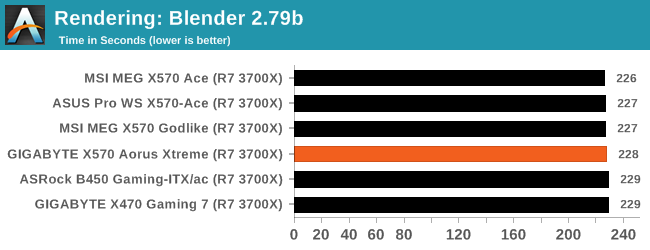
Streaming and Archival Video Transcoding - Handbrake 1.1.0
A popular open source tool, Handbrake is the anything-to-anything video conversion software that a number of people use as a reference point. The danger is always on version numbers and optimization, for example the latest versions of the software can take advantage of AVX-512 and OpenCL to accelerate certain types of transcoding and algorithms. The version we use here is a pure CPU play, with common transcoding variations.
We have split Handbrake up into several tests, using a Logitech C920 1080p60 native webcam recording (essentially a streamer recording), and convert them into two types of streaming formats and one for archival. The output settings used are:
- 720p60 at 6000 kbps constant bit rate, fast setting, high profile
- 1080p60 at 3500 kbps constant bit rate, faster setting, main profile
- 1080p60 HEVC at 3500 kbps variable bit rate, fast setting, main profile
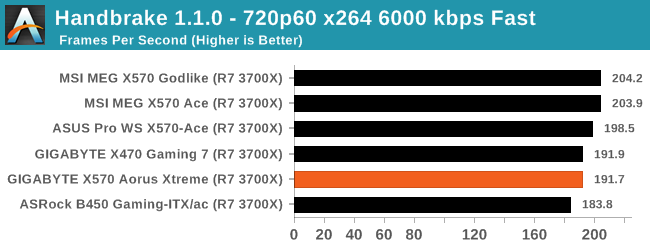
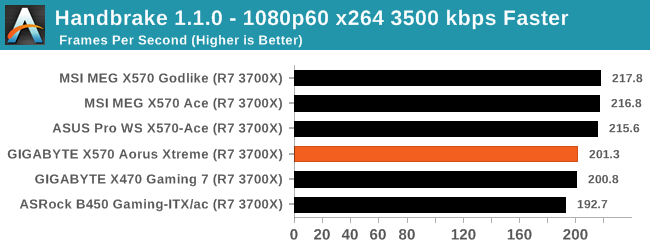

Rendering – POV-Ray 3.7.1: Ray Tracing - link
The Persistence of Vision Ray Tracer, or POV-Ray, is a freeware package for as the name suggests, ray tracing. It is a pure renderer, rather than modeling software, but the latest beta version contains a handy benchmark for stressing all processing threads on a platform. We have been using this test in motherboard reviews to test memory stability at various CPU speeds to good effect – if it passes the test, the IMC in the CPU is stable for a given CPU speed. As a CPU test, it runs for approximately 1-2 minutes on high-end platforms.
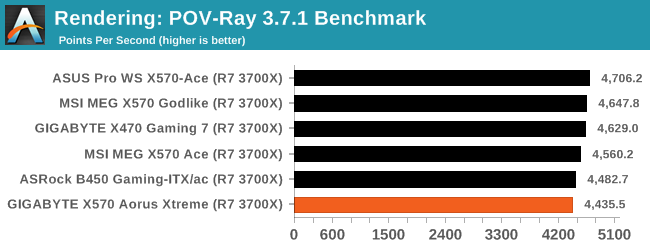
Compression – WinRAR 5.60b3: link
Our WinRAR test from 2013 is updated to the latest version of WinRAR at the start of 2014. We compress a set of 2867 files across 320 folders totaling 1.52 GB in size – 95% of these files are small typical website files, and the rest (90% of the size) are small 30-second 720p videos.
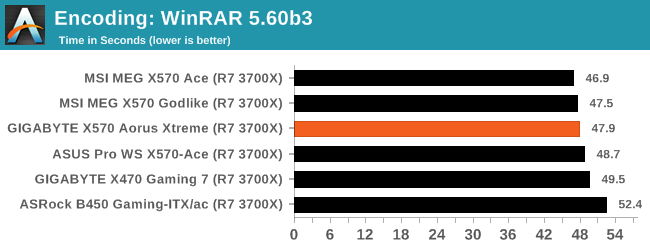
Synthetic – 7-Zip v1805: link
Out of our compression/decompression tool tests, 7-zip is the most requested and comes with a built-in benchmark. For our test suite, we’ve pulled the latest version of the software and we run the benchmark from the command line, reporting the compression, decompression, and a combined score.
It is noted in this benchmark that the latest multi-die processors have very bi-modal performance between compression and decompression, performing well in one and badly in the other. There are also discussions around how the Windows Scheduler is implementing every thread. As we get more results, it will be interesting to see how this plays out.
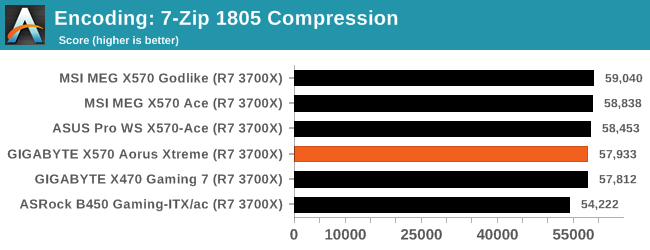
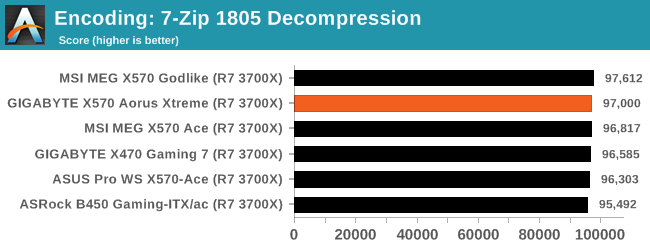
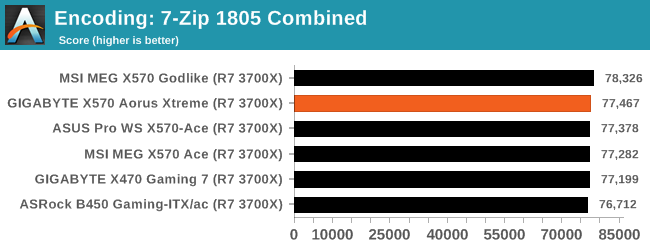
Point Calculations – 3D Movement Algorithm Test: link
3DPM is a self-penned benchmark, taking basic 3D movement algorithms used in Brownian Motion simulations and testing them for speed. High floating point performance, MHz, and IPC win in the single thread version, whereas the multithread version has to handle the threads and loves more cores. For a brief explanation of the platform agnostic coding behind this benchmark, see my forum post here.
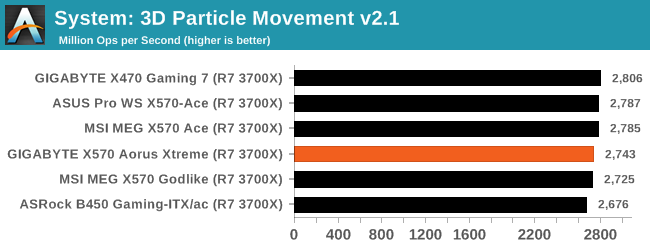
Neuron Simulation - DigiCortex v1.20: link
The newest benchmark in our suite is DigiCortex, a simulation of biologically plausible neural network circuits, and simulates activity of neurons and synapses. DigiCortex relies heavily on a mix of DRAM speed and computational throughput, indicating that systems which apply memory profiles properly should benefit and those that play fast and loose with overclocking settings might get some extra speed up. Results are taken during the steady-state period in a 32k neuron simulation and represented as a function of the ability to simulate in real time (1.000x equals real-time).
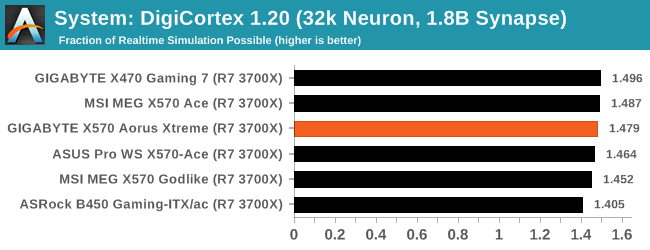










42 Comments
View All Comments
Kurosaki - Tuesday, September 24, 2019 - link
Yes, but where do the M2 ssd's go?! :DKWottrich - Tuesday, September 24, 2019 - link
Two between the PCIe slots (there are screws to open up panels in the metal plate covering the lower part of the board), and one on the back. The one on the back is the one that disables 2 SATA ports if used, as noted in the final page of the article.Aenra - Tuesday, September 24, 2019 - link
Am now wondering if this is the same "reviewer" responsible for the semi-recent Supermicro review.If so, hardly surprised. And regardless.. a 3700X? Seriously? You pick up a behemoth and test it, how? With a 3700X.. well done; again, if it's indeed the same person. Why not a 3400G? I mean it's AM4 and everything, right?
(and if it is the same person, chances are that as with the previous article, i'd find even more glaring issues to name, except this time i can't even bother to read it all; stopped at '3700X')
This site does amazing hard drive reviews; very good CPU reviews; exceptional editorials; but needs some serious love in its mobo review department. It's honestly a shame, stands out compared to the rest.
Respectfully, your average lurker.
shabby - Tuesday, September 24, 2019 - link
What would be the point in testing a 12/16 core? Any x570 board can run one at 4.3ghz+, the board isn't the bottleneck it's the cpu.Death666Angel - Tuesday, September 24, 2019 - link
"semi-recent Supermicro review" If we mean the same thing (C9Z390-PGW), then that review was February 1st. We have very different meanings of "semi-recent" then. And it was also Gavin Bonshor who did that review.imaheadcase - Tuesday, September 24, 2019 - link
If you can't even bother to read the reviewer name in top of article and compare it to another article, and can't read past a single word in this article. What are you even doing here if can't finish simple things.TheinsanegamerN - Tuesday, September 24, 2019 - link
What would you suggest then smart guy? A 3800x that hits the same clock rates +/- 25 MHz? A 3900x that nobody can get ahold of and will hit the SAME clock ceiling?Go back to lurking.
SSTANIC - Tuesday, September 24, 2019 - link
They have been testing it with a 3950X, but its launch and NDA (Sep 30th) have been postponed to November..Smell This - Tuesday, September 24, 2019 - link
"As it currently stands, the GIGABYTE X570 Aorus Xtreme includes the best power delivery of any X570 motherboard we have seen so far in our testing."_____________________________________________________________
Uhhh .... yeah. It thumped the competition, hands down. Nice job, GB.
DanNeely - Tuesday, September 24, 2019 - link
Unless they're including a right angle adapter I think the side pointed 24-pin ATX connector is risky idea. If you're running the cable on the same side of the mobo-tray as the board it's not an issue, but most high end cases today route the cables behind the board with holes just outside. 24 pin cables are really stiff if the wires are bundled together; I had a board with a 90 power plug a about a decade ago (was either LGA1366 or S939) of years ago and the all in a single bundle cable from the PSU wouldn't make the bend; I ended up having to run a big loop into the drive bay area and ended up with more of the cable sticking out than for a conventional top down plugin. Even with that the cable was still very difficult to bend into place to insert and was putting a lot of tension onto the board trying to lift it up from the tray afterward. Individually sleeved wire designs might be OK if you've got a long length from the plug to the last point they're zip-tied together, but a standard fat bundle is asking for trouble.